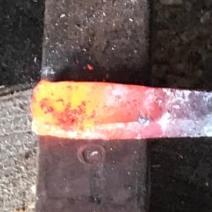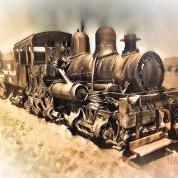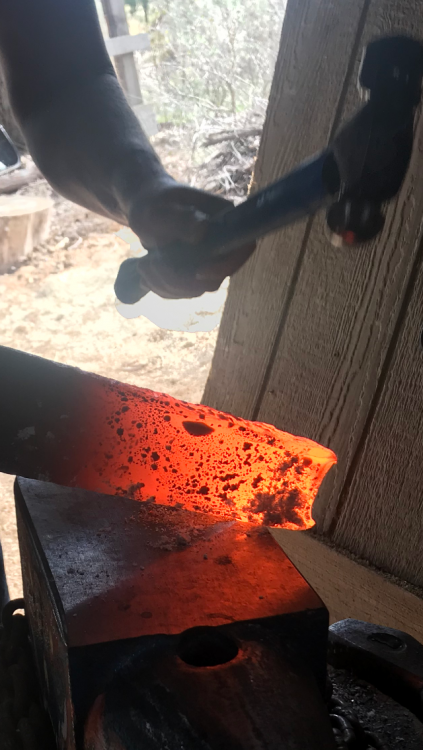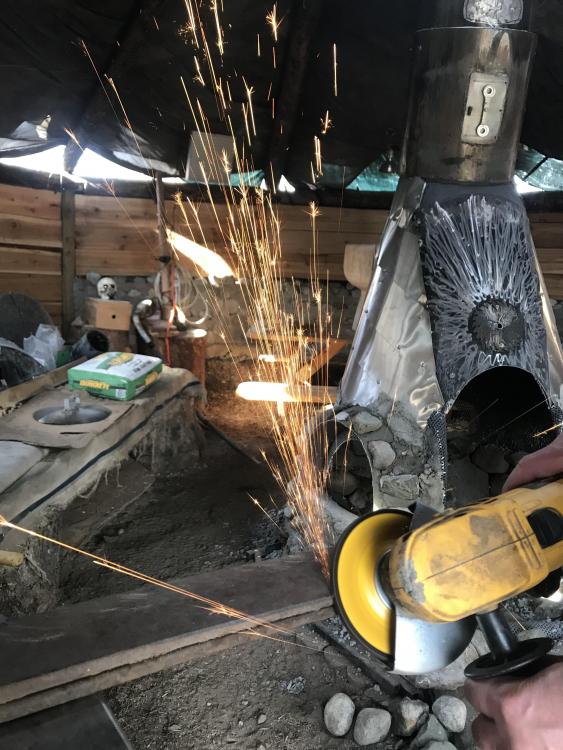-
Posts
119 -
Joined
-
Last visited
Profile Information
-
Gender
Male
-
Location
north Washington
-
Interests
Raising chickens and goats, chainsaw carving, guitar, djembe drumming, running, hiking, wood fire
Recent Profile Visitors
-

Portable cordless bandsaw recommendations
Will-I-am replied to BillyBones's topic in Saws, bandsaws, hack saws, etc
-
Mr. Powers, I do not think I can get the temp hot enough to hot cut yet. I would love to hot cut, but still working on temperature refinements. I would have to cut on edge of anvil since I do not have a hardy hole cutter or good chisels yet. Holding the hot metal steady while using chisel is more advanced for my current level. No vice either just vice grips and first tongs that only hold larger round stock comfortably. I am still learning to draw out metal. I like the way the ball peen hammer works on the anvil edge, very fulfilling. I will continue to draw out the machete handle until it is round and I can hold it comfortably. Then I will heat the blade side and start drawing out the blade on both sides and then final sharpen with angle grinder. I want to shape the whole blade by heating, just for the experience. Originally, I tried to cut the stock closer to a bowie knife size but the leaf spring was way harder than any steel I have ever tried to cut with jigsaw or reciprocal saw. These saws literally bounced off the metal, so I used angle grinder which was very difficult even with cooling oil. Almost burned up grinder and used 1/2 disk for 3 cuts through spring steel, one point and one heel. I want to hammer the blade angle instead of grinding it to shape. Hot cutting intimidates me for now. Holding a luminous piece of metal and hammering is enough for me right now. Safety is important; some of that hot hammered scale flew off and landed on my feet and legs but luckily I was barefoot and instantly moved, similar to hammering without gloves.
-

What did you do in the shop today?
Will-I-am replied to Mark Ling's topic in Blacksmithing, General Discussion
Since the carborizing process (adding carbon to reduced oxygen iron in bloomery) is only on the surface of billet, would this account for differences in rust? The final forge welded helix would be twists of high carbon and low carbon and rust at different rates? -

What did you do in the shop today?
Will-I-am replied to Mark Ling's topic in Blacksmithing, General Discussion
Thanks Mr. Powers. I looked up the term pattern welding. https://en.wikipedia.org/wiki/Pattern_welding. Very interesting. It talks about the Vikings twisting long bars together forge welding and then repeating. This helix pattern is the Wurm you are referring to? -

Brick side draft chimney plans?
Will-I-am replied to will52100's topic in Chimneys, Hoods, and Stacks
This Sauder guy has an interesting plan for incorporating regular .50cent bricks with a fireclay ($9 for 50 lb bag special ordered at building supply) mortar. Then stacking mixed fireclay balls around a wood form to form chimney that will withstand 3000degree heat. Regular mortar cracks under high heat but fireclay melts to ceramic. This plan idea could be incorporated into a coal chimney design. https://s3.amazonaws.com/images.icompendium.com/sites/eliz2406/sup/3696366-furnace-construction.pdf -
Substituted new 9” diameter centrifugal tuyere fan for old 4” fan. Twice cfm, 4xwatts and way more push and only 50 decibels quiet. On high the fan cools material but on low it is perfect but gobbles up wood. Cut 30lb spring steel found on hike; still sore from hauling on back 4 miles. New jigsaw blades didn’t dent steel and reciprocal saw was similar, so had to angle grind. Used grinding oil but was a chore. Originally wanted to make Bowie but would need more disks so now a machete. Spent all day trying to draw out handle using ball peen and edge of anvil. Fan made fire a little hotter, hot enough to see first black chunks of scale over yellow. Hands sore. A good day.
-
Concerning my above pic of spark test. Looking at spark chart images my greenhorn opinion would be mild but shouldn’t the spark be white and not straw color? Since leaf spring was found off old logging/ mining road 4 miles deep from both directions, up 1500 ft in dry cold desert climate, near copper mines. Mining truck leaf spring over 50 years old? Ore trucked down steep rocky dusty bumpy roads. Then ore put on trains in flat. More info to help with identification.
-
Me and the wife went on 8 mile hike over the mountain today. Checking out old copper mine, found 30 lb 5ft tall leaf spring. Hauled back on sore shoulders for 4 miles! Did spark test. Medium carbon steel, good for first knives?
-
Frazer, this is different from a regular booster fan. The old 100cfm fan which was regular 4" "almost" worked even after 2x 90degree bends and 10' 1" pipe, I got the material always bright orange and sometimes yellow. It was 15 watts the new one is around 60 watts. Yes, there was back pressure and yes there was ash buildup. This new fan is different, the larger centrifugal 9" flywheel combined with twice the cfm should overcome backpressure and certainly be a large gain from the old fan. I expect more yellow. Also the fan blades are spinning so that there is little friction which will also lead to less backpressure, see pic. Plus very quiet.
-
I ordered this vivosun 4" fan and it will arrive in the mail tomorrow. It is variable speed so dialing it in for multiple forge types should work. I was using a hvac booster fan with only 100cfm and it would not get the material color past bright orange. This new fan is twice the cfm and also is a larger 9" centrifugal like the hand cranks which has more push and less backpressure when ash, clinker and whatever tries to clog/block the tuyere. I cost $50. excited!
-

What did you do in the shop today?
Will-I-am replied to Mark Ling's topic in Blacksmithing, General Discussion
Lee Sauder's area on his site called "smelting research" has quite a number of research papers that are a highly educational read. Just finished reading 5 papers he wrote on bloomery and he even has one just on bloomery construction plans with lots of pictures in each paper. His concepts and his "clay mix" could be incorporated into normal forge builds. Gets the creative juices flowing. -

What did you do in the shop today?
Will-I-am replied to Mark Ling's topic in Blacksmithing, General Discussion
just typing in Lee Sauder in the search bar on this blog get 72 hits, way more if I use a search engine. Why would a link to his website be removed, I could not find a reason in the rules? His research papers are a foundational read. -

What did you do in the shop today?
Will-I-am replied to Mark Ling's topic in Blacksmithing, General Discussion
I was digging through this blog looking for more information on bloomery and someone recommended checking out this guy. Wow! link removed His research papers are especially interesting. Forging totally from scratch from ore to axe. Converting iron oxide to iron and adding carbon to iron in a fire. There are a lot of copper and gold mines here in northern washington. Ideas are flowing. -

What did you do in the shop today?
Will-I-am replied to Mark Ling's topic in Blacksmithing, General Discussion
It would be really satisfying to create a knife from a primitive bloomery. I found this fun link with lots of pictures of a modern viking age bloomery reproduction. http://www.hurstwic.org/history/articles/manufacturing/text/bog_iron.htm -

What did you do in the shop today?
Will-I-am replied to Mark Ling's topic in Blacksmithing, General Discussion
Mr. Powers, what an amazing experience it must had been to participate at Pennsic all those years. Did your Scandinavian team build the bloomery from scratch each year? I am curious about the short stack build, any pics? Even better is if you have a link to the ironmaster research paper, would love to read it?





